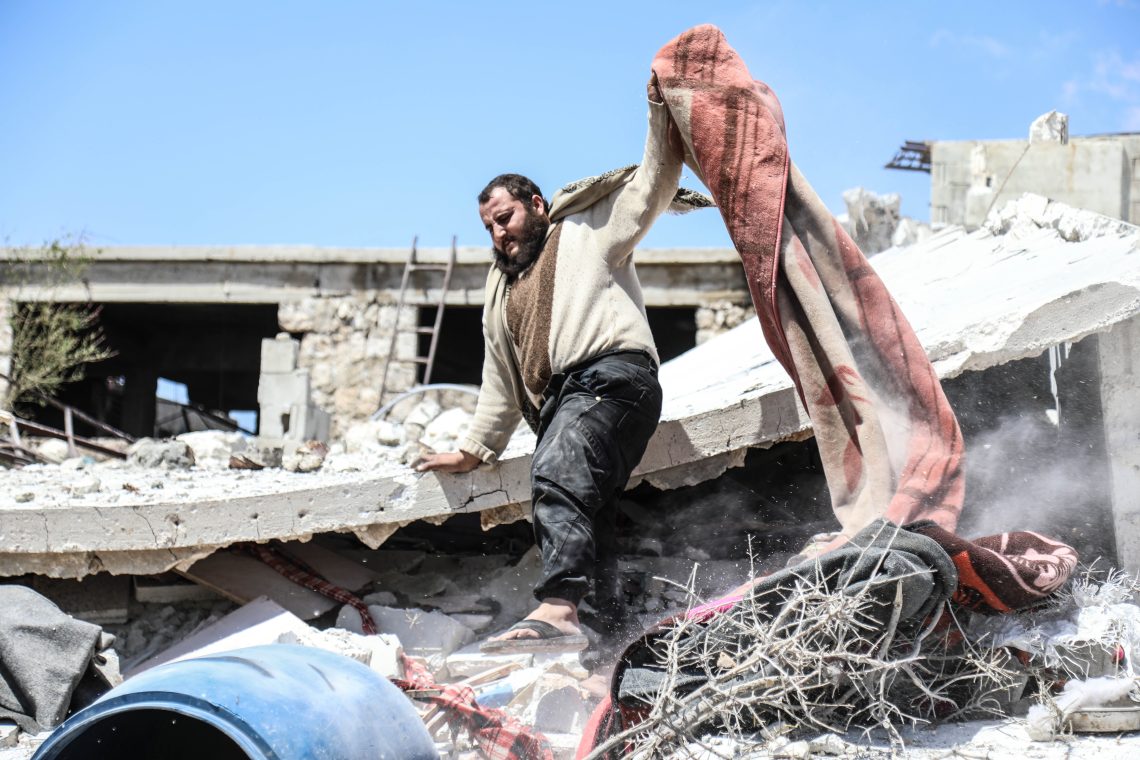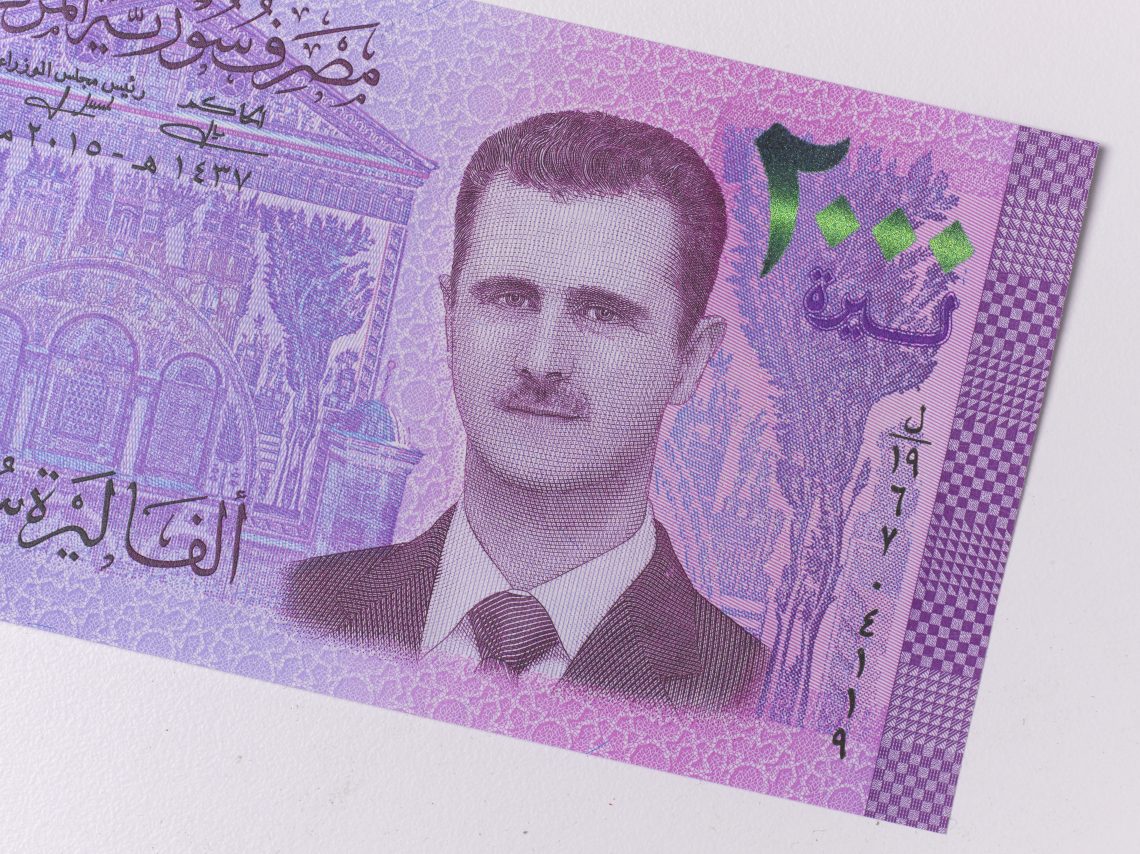Syria’s Assad is an unlikely survivor
While Bashar al-Assad has survived the 11-year-old civil war, he barely controls 60 percent of Syrian territory. The West is blocking attempts to rehabilitate the accused war criminal.

In a nutshell
- Bashar al-Assad has lost control of much of his country
- Russia, Turkey and Iran don’t want to withdraw from Syria
- As peace talks fail, Israel-Iran conflicts are more likely
Situated in the middle of the rich lands stretching from the Eastern Mediterranean to the Persian Gulf through the Tigris and Euphrates rivers – the so-called Fertile Crescent – Syria enjoys a unique strategic position in the Arab world. Bordered by Lebanon, Jordan, Iraq, Turkey and Israel, its coastal line affords access to Europe and Africa through the Mediterranean Sea. Its 185,120 square kilometers make it twice the size of Portugal.
However, it has not emerged unscathed from 11 years of civil war. Bashar al-Assad has lost control of vast swaths of his country. Turkey has conquered some of its territories, while the Kurds still hold large tracts in the northeast and have declared a de facto autonomy. Parts of Idlib province are still in the hands of the rebels. Russia and Iran, the two powers that helped the much-reviled president to remain in power, have no intention to leave. Iran was pursuing its goal of imposing a Shia regime on the Arab world and establishing a base to attack Israel. Russia was following a policy already implemented by the tsars in seeking to bypass the Bosporus Strait and the Dardanelles by gaining access to the Mediterranean Sea.
Tehran’s encroachments
Today there are ongoing attempts by several Arab states and Israel to force an Iranian withdrawal from Syria or at least to curtail its encroachments. They are worried by Tehran’s moves to change Syria’s status as a Sunni country and by its aggressive, destabilizing military and civilian activities, which prevent much-needed reconstruction efforts. President Assad would like these attempts to force out Iran to succeed but is powerless to achieve this goal.
Through the course of the bloody civil war and its savage repression, at least 600,000 Syrians lost their lives; half of the country’s population was displaced, and millions fled abroad. The economy is in ruins; worse, the regime barely controls 60 percent of its former territories. Fighting still goes on, though on a much-reduced scale, since Russian forces and Shia Iranian militias swiftly repress renewed rebel or Islamic State (also known as ISIS or Daesh) activities.
Today some Arab states believe that Mr. Assad’s survival is necessary to ensure relative stability and are ready to help him claw back his way to international legitimacy.
Many Arab countries closed their embassies in Damascus as early as 2012 and the Arab League suspended Syria after the United Nations General Assembly accused President Assad of crimes against humanity and war crimes. League members also demanded his ouster. Yet today some Arab states believe that Mr. Assad’s survival is necessary to ensure relative stability and are ready to help him claw back his way to international legitimacy to help him against Iran. It is mainly due to the United States declaring its intention to withdraw from the Middle East and to revive the defunct Joint Comprehensive Plan of Action, designed to prevent Iran’s acquisition of nuclear weapons, as well as to the cooling of relations between Washington and Riyadh. No longer sure that they can depend on America, Sunni countries and especially the Gulf states are weighing the possibility of forming a coalition that would stand firm against Iran and defuse Turkey’s hostility toward Mr. Assad.
The United Arab Emirates was the first to act. They reopened their embassy in 2018 after Russia and the U.S. had pronounced – somewhat prematurely – that the civil war in Syria was over. The two great powers, which had acted separately, were boasting of their success; Washington, for having ousted ISIS from its strongholds while Moscow rejoiced at the defeat of rebel forces that had U.S. support.
Syria was in a parlous state, the regime not really in control. Mohammed bin Zayed, who became president of the United Arab Emirates on May 14, 2022, a day after the death of his half-brother, Sheik Kalifa, thought that the time had come to bolster Mr. Assad in the hope that all other Arab states would follow suit. And some did. Bahrain reopened its embassy in December of the same year, and Jordan restarted the main crossing point into Syria and sent a charge d’affaires to Damascus. A meeting was held in Egypt between heads of the security services.
Also on Syria by Zvi Mazel
- In fragmented Syria, the battle for control escalates
- Syria’s relentless war
- Iran and Israel’s proxy war in Syria escalates
Other countries were slower to join, cautiously waiting for world reaction. May 2020 saw a meeting in Damascus between the heads of intelligence services of Syria and Saudi Arabia to discuss normalization. A Syrian delegation led by the minister of tourism then went to Riyadh. The Saudis did not pursue the issue and are still hesitating; they have held several meetings with Iran to explore a possible understanding, with no breakthrough so far.
The Arab League is yet to allow Syria back into the fold. Several Arab states oppose its return until there are results of the Geneva peace talks between the Syrian government and the opposition under the auspices of the United Nations. Qatar, which maintains a dialogue with Iran and is a strong supporter of Islamic militias in Syria, spearheads the opposition. Foreign ministers of Arab League members who met in Kuwait in February 2022 could not reach a decision.
A month later, on March 18, Mr. Assad went to Abu Dhabi – his first visit to an Arab country since 2011 – in spite of U.S.-imposed sanctions and met with Dubai’s powerful ruler Sheikh Mohammed bin Rashid Al Maktoum and later with now-President Mohammed bin Zayed, who was quoted as stating that “Syria is an essential pillar of Arab security and therefore the UAE position is consistent in its support for the unity of Syrian territory … and the need for the withdrawal of all foreign forces illegally present there.”
There were talks of commercial and financial cooperation toward the reconstruction of Syria. Mr. Assad warmly thanked his hosts, stressing that the principles of sovereignty and the interests of all people of the region had to be observed. U.S. State Department spokesman Ned Price said that the U.S. was “deeply disappointed and disturbed” by Mr. Assad’s visit, calling it a “clear attempt to legitimize” the Syrian leader “who remains responsible and accountable for the death and suffering of countless Syrians.”
Facts & figures
Undeterred, the UAE explored another avenue and resumed its dialogue with Turkey, which openly supports the Muslim Brotherhood, seen by Abu Dhabi as a terrorist organization. Turkey is deeply implicated in Syria. With the help of Islamic Syrian militias, it has conquered the Afrin Kurdish region to cut off the YPG – a branch of the Syrian Democratic Forces it saw as an ally of the Kurdistan Workers’ Party, known as PKK – from its border. It then expelled 300,000 people from Afrin and replaced them with its supporters. Turkey also backs rebel organizations in Idlib against the regime. At the same time, as a member of the Astana forum, it coordinates actions in Syria with Russia and Iran. The UAE is working to temper its hostility toward Mr. Assad to reinforce the Syrian ruler in his confrontation with Tehran.
Israel’s role
Behind the scenes, Israel is a major element in the unlikely coalition the UAE is trying to set up. The 2020 Abraham Accords – which led to diplomatic relations between Israel and the UAE, Bahrain, Morocco and Sudan – also strengthened collaboration on security and intelligence issues. That coalition is yet to be full-fledged but it holds the seeds of active cooperation against Iran, which is already reacting by warning the Gulf states not to open such a front. Tehran is also threatening Israel with swift and strong reprisals. Warnings and threats are expected to escalate should the coalition take form. Assad’s surprise visit to Tehran on May 8 demonstrates that the relations between the two countries remain strong.
Western countries cannot be persuaded to thwart Iran by rehabilitating the Assad regime.
Are these measures likely to strengthen the Damascus ruler? Probably not, considering the magnitude of obstacles along the way. First, the U.S. wants no part in the process and is not ready at this stage to cancel sanctions against the Syrian president and take part in the reconstruction of Syria. The Democratic administration has made human rights a cornerstone of its policy. Turning a blind eye toward the crimes of Mr. Assad would defeat that purpose.
Yet Washington also would like to see foreign forces leaving Syria and the beginning of reconstruction work while insisting on a transition to a new regime enabling the return of an independent Syria. Recently, the easing of possible sanctions envisioned by the Caesar Syria Civilian Protection Act of 2019 appeared with U.S. support for the delivery of Egyptian natural gas to Lebanon by the Arab pipeline through Jordan and Syria. Actually, this supply is Israeli gas to Egypt.
The lack of trust of Saudi Arabia and the Emirates toward the U.S. is not abating. Riyadh turned a deaf ear to American entreaties to increase its oil production for export to ease the energy crisis due to the war in Ukraine. Washington had also angered Gulf states when it had granted Qatar the status of major non-NATO ally because it agreed to host U.S. negotiations with the Taliban, which did not yield the hoped-for results. Openly supporting the Muslim Brotherhood, al-Qaeda and other militant Islamic groups, Qatar maintains a dialogue with Iran. The Gulf states see these policies as a danger to the region despite the reconciliation summit held in January 2021 at Al-Ula in Saudi Arabia.

Additionally, minimum economic, social and political conditions for the massive investments needed for the reconstruction of Syria are yet to be met. Estimates run as high as more than $400 billion. About half of Syria’s pre-war 2011 population of 22 million has been displaced, with 6.9 million living inside Syria and 5.6 million living in neighboring countries. Only a small minority managed to reach Europe.
Despite Mr. Assad’s survival, the political and military situation is too uncertain to convince investors. Russia, Iran and Turkey do not intend to withdraw their forces and are severely curtailing the regime’s freedom of action. Daesh has resumed its attacks in the last few months, potentially making civilian construction work uncertain. The war is not over, and low-grade fighting is ongoing, threatening stability.
Then there is the Iran-Israel confrontation, with hostilities carried out on Syrian territory. Iranians are making an all-out effort to insert themselves into the social, religious and economic fabric and maximize the Shia influence in predominantly Sunni Syria. They help Shia refugees settle in villages left empty by Sunnis fleeing the battles, helped create a Shia quarter in Damascus and give financial incentives to pilgrims wishing to visit Shia holy places in Syria. Iran concluded wide-ranging trade and economic agreements with Syria, set up trade centers in Damascus and in Aleppo, and even provide medical and benevolent assistance.
At the same time, it is reinforcing Shia militias, and installing anti-missile systems throughout the country. It endeavors to assist Hezbollah to establish terror outposts on the Golan Heights to harass and threaten Israel, but also by sending to that organization precision missiles and technical means to produce them. Facing this vital threat, Israel launches bombing raids on the convoys and depots, forcing Iran to reduce the scope of its activities. There is no end in sight and the ayatollahs will keep on doing their utmost not to lose their hold on Syria since it would deal a stunning blow to their prestige and could bring about their downfall.
The major military force, Russia, has no intention to leave but did withdraw some troops because of the war in Ukraine. Pro-Iranian militias were quick to move in their stead to the suburbs of Homs and to Tadmur military airport.
Meanwhile, the decade-old UN-led Geneva process to foster direct talks between the Assad regime and rebel representatives is going nowhere. European countries and the U.S. still have forlorn hopes of success. There were meetings in March 2022 with no significant results. The Astana forum, also attempting to draft a new constitution and determine the new map of Syria, is not faring any better. Its three members, Russia, Turkey and Iran, are merely using it for tactical briefings.
Scenarios
On the face of it, there is no solution in sight. The UAE and its followers failed to convince the Arab League’s members to resume diplomatic relations with Syria. Western countries, the European Union and the U.S. cannot be persuaded to thwart Iran by rehabilitating the Assad regime, accused of horrendous war crimes. Without them, there can be no effective coalition against the ayatollahs.
Absent such a coalition, Iran will not withdraw from Syria and will not sever its links with Hezbollah. There is a very real risk of direct conflict with Israel. Much will depend on the revival of the Joint Comprehensive Plan of Action so ardently sought by Washington and the conditions set down. A situation might arise in which Israel would feel compelled to act alone with the Gulf states remaining on the sidelines, apart from supplying intelligence.








